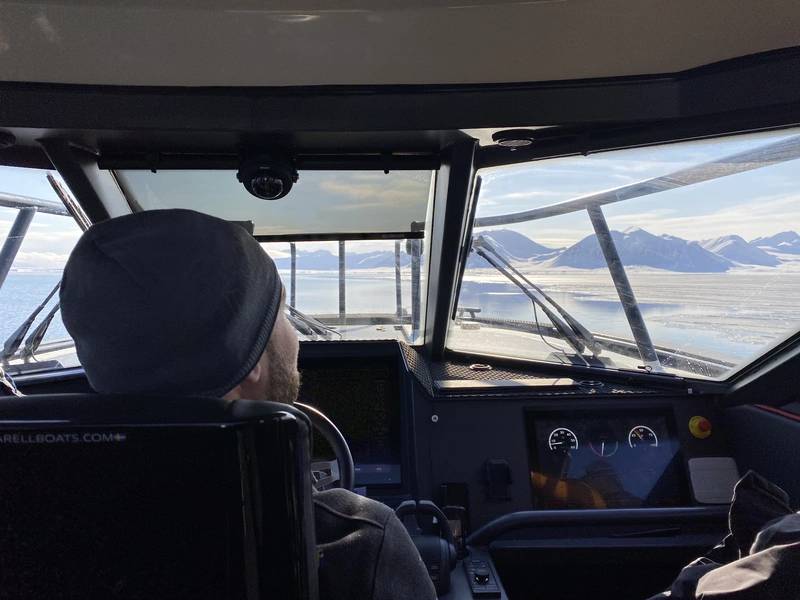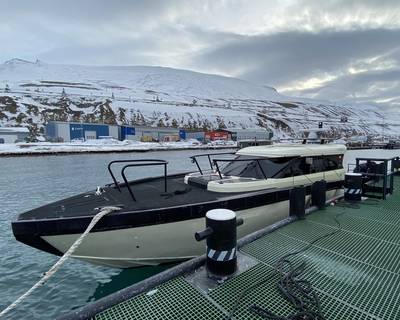Hybrid-electric Tour Boat Enters Service in Svalbard
High-latitude tourism company Hurtigruten Svalbard has launched a first-of-its kind hybrid-electric excursion vessel in Longyearbyen, just 800 miles from the North Pole.
The 14-meter vessel, Kvitbjørn, runs on a hybrid-electric propulsion system developed by Volvo Penta in partnership with Swedish boatbuilder Marell Boats and Hurtigruten Svalbard.
The new 12-passenger aluminum vessel, which will take sightseers on wilderness tours around Svalbard during the local tourist season from May through October, was delivered to the remote archipelago on April 19 and was put through its paces in a series of trials before entering service on May 5. The boat also underwent extensive testing in Sweden prior to delivery.
Powered by a Volvo Penta twin D4-320 DPI Aquamatic hybrid solution, the boat has a top speed of 30-32 knots and a cruising speed of 24-25 knots, with a range of 500 nautical miles. The “helm to propeller” propulsion system from Volvo Penta includes the engine and driveline, the electronic vessel control (EVC) system, joystick control, dynamic positioning system and the driver interface. The capacity of vessel's lithium ion batteries is 100 kilowatt-hours (kWh).
Tore Hoem, adventures director at Hurtigruten Svalbard, said the company had considered ordering a vessel with other propulsion options such as more traditional outboard engines, but ultimately opted for Volvo Penta’s hybrid-electric solution based on the improved passenger experience as well as its environmental advantages.
“The difference from a traditional boat is the feeling of silence. In electric mode, you can hear the sound of the glacier ice in the water, the breath of walruses—it will allow us to offer a truly unique experience to our customers. Enabling the optimal mix of low-speed, silent cruising, and the ability to cover a lot of distance for the 3-4-hour duration of the tour,” Hoem said.
Gerard Törneman, key account manager for commercial vessels at Marell Boats, said, “We collaborated from the beginning to identify the ideal boat design for the ultimate operation and sightseeing experience. Marell’s and Volvo Penta’s technicians have worked well together regarding the design and installation of important supporting systems for the arctic climate, like heating, ventilation and charging system. This kind of collaboration is essential with hybrid and electric solutions to ensure the technology is an ideal fit for the intended use case.”
 Tore Hoem, adventures director at Hurtigruten Svalbard, pilots Kvitbjørn. (Photo: Eric Haun)
Tore Hoem, adventures director at Hurtigruten Svalbard, pilots Kvitbjørn. (Photo: Eric Haun)
Kvitbjørn comes amid wider sustainability efforts being led by both the Hurtigruten Group and Volvo Penta in parallel with tourism and marine industry peers striving to reduce their environmental impacts. Increasingly, hybrid and electric propulsion solutions are gaining interest among marine operators working to slash emissions across various sectors.
Johan Inden, president of the Volvo Penta Marine Business Unit, said, “We see electromobility as an enabler for many marine commercial operations—that have short, dedicated journeys—as our industry strives towards a zero CO2 emissions future. The Kvitbjørn operation fits our expected electromobility user case and we’re excited to learn how we can accelerate the journey toward sustainability, together.”
As the vessel goes to work, Volvo Penta will analyze fuel savings and emissions reductions enabled by the hybrid-electric solution, Inden said.
In addition, over the course of the next three years, the companies will test the electromobility technology as well as Volvo Penta’s new “e-mobility-as-a-service” business model, which will see Hurtigruten Svalbard pay by the kilowatt-hour for the vessel’s operation. This payment model, while still at a concept stage, has been conceived as a way of risk-sharing between Volvo Penta and the end-user as upfront costs for marine e-mobility solutions are typically higher.
“We must undertake pilot programs like this collaboration with Hurtigruten Svalbard and Marell Boats," Inden said. “We’re looking at the bigger picture here, it’s not just about testing a hybrid propulsion system, it's about looking at how we can adapt our unique features – the DPS and joystick for instance—for hybrid and electric use. Testing our solutions in this extreme environment and trialing new business models will enable us to continue to innovate and explore—all with the aim to deliver an unrivaled experience on the water—in this case, helping to enable the ultimate adventure at sea.”












